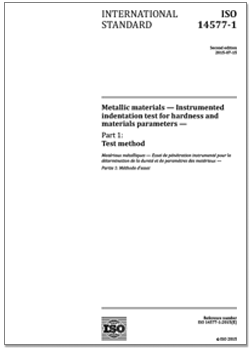INTERNATIONAL STANDARD ISO 14577-1:2015
Metallic materials — Instrumented indentation test
for hardness and materials parameters —
Part 1:
Test method
ISO 14577 consists of the following parts, under the general title
Metallic materials —— Instrumented indentation test
for hardness and materials parameters:
ISO 14577-1:2015, Metallic materials — Instrumented indentation test
for hardness and materials parameters — Part 1: Test method
ISO 14577-2:2015, Metallic materials — Instrumented indentation test
for hardness and materials parameters — Part 2: Verification and calibration of testing machines
ISO 14577-3:2015, Metallic materials — Instrumented indentation test for hardness and materials parameters — Part 3: Calibration of reference blocks
ISO 14577-4:2016, Metallic materials — Instrumented indentation test for hardness and materials parameters — Part 4:Test method for metallic and non-metallic coatings
Contents
Foreword
Introduction
1 Scope
2 Normative references
3 Symbols and designations
4 Principle
5 Testing machine
6 Test piece
7 Procedure
8 Uncertainty of the results
9 Test report
Annex A (normative) Materials parameters determined from the force/indentation depth data set
Annex B (informative) Types of control use for the indentation process
Annex C (normative) Machine compliance and indenter area function
AnnexD (informative) Notes on diamond indenters
Annex E (normative) Influence of the test piece surface roughness on the accuracy of the results
Annex F (informative) Correlation of indentation hardness H IT to Vickers hardness
Annex G (normative) Drift and creep rate determination
Annex H (informative) Estimation of uncertainty of the calculated values of hardness and materials parameters
Annex I (normative) Calculation of radial displacement correction
Bibliography
1 Scope
This part of ISO 14577 specifies the method of instrumented indentation test for determination of hardness and other materials parameters for the following three ranges:
— macro range: 2 N ≤ F ≤ 30 kN;
— micro range: 2 N > F; h > 0,2 μm;
— nano range: h ≤ 0,2 μm.
For the nano range, the mechanical deformation strongly depends on the real shape of indenter tip and the calculated material parameters are significantly influenced by the contact area function of the indenter used in the testing machine. Therefore, careful calibration of both instrument and indenter shape is required in order to achieve an acceptable reproducibility of the materials parameters determined with
different machines.
The macro and micro ranges are distinguished by the test forces in relation to the indentation depth.
Attention is drawn to the fact that the micro range has an upper limit given by the test force (2 N) and a lower limit given by the indentation depth of 0,2 μm.
The determination of hardness and other material parameters is given in Annex A.
At high contact pressures, damage to the indenter is possible. For this reason in the macro range hardmetal indenters are often used. For test pieces with very high hardness and modulus of elasticity, permanent indenter deformation can occur and can be detected using suitable reference materials. It is necessary that its influence on the test result be taken into account.
This test method can also be applied to thin metallic and non-metallic coatings and non-metallic
materials. In this case, it is recommended that the specifications in the relevant standards be taken into account (see also 6.3 and ISO 14577-4).
2 Normative references
The following documents, in whole or in part, are normatively referenced in this document and are indispensable for its application. For dated references, only the edition cited applies. For undated references, the latest edition of the referenced document (including any amendments) applies.
ISO 14577-2:2015, Metallic materials — Instrumented indentation test for hardness and materials
parameters — Part 2: Verification and calibration of testing machines
ISO/IEC Guide 98-3:2008, Uncertainty of measurement — Part 3: Guide to the expression of uncertainty in measurement (GUM:1995)
3 Symbols and designations
For the purposes of this document, the symbols and designations in Table 1 shall be applied (see also Figure 1 and Figure 2).
在線閱讀 免費下載







